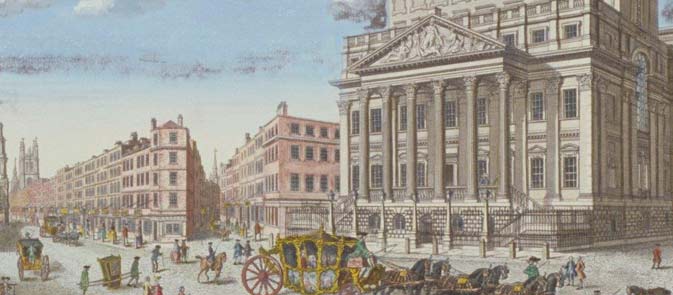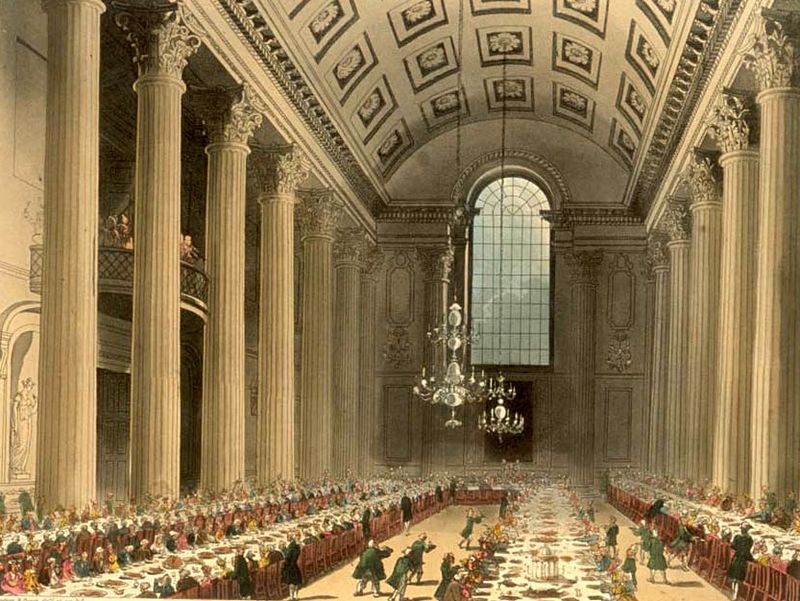The Susie Zone - Exploring Mansion House (January 2018)
Exploring Mansion House
The Home of the Lord Mayor of London
by Susie J. Briscoe
I thought we might start with something a little different and take a look at the home of The Lord Mayor of London and its history.
Starting with my personal connections...
 I have done voluntary work for four Lord Mayors of London: Sir Greville Spratt, Sir Christopher Collet, Sir Hugh Bidwell, and Sir Paul Newall. Over these years, I became very familiar with the House, its workings and the marvelous people who hold it all together.
I have done voluntary work for four Lord Mayors of London: Sir Greville Spratt, Sir Christopher Collet, Sir Hugh Bidwell, and Sir Paul Newall. Over these years, I became very familiar with the House, its workings and the marvelous people who hold it all together.
My role was involved with the Lord Mayor’s Annual Charity Appeal and it allowed me a triple ‘A’ (Access All Areas) pass not just to Mansion House (indeed, I stayed several times overnight - a great honour for State visitors), but also the Guildhall of London, The Palace of Westminster, as well as St. Paul’s Cathedral – all places where I held events to raise funds on their behalf. It was tremendous fun and raised significant amounts of money for their respective charities.
The Mansion House Fair, which I chaired, was the first one in its history and the (then) Lord Mayor Spratt had to get special permission to have money exchange hands as it is usually against House rules. In the event we had an amazing day: an organ grinder played a welcome as guests arrived in Walbrook Hall, and then, when they went upstairs to the State Rooms, they were greeted with all manner of circus folk from stilt walkers and clowns, jugglers, and acrobats, Pierrot and Pierrette, as well as lots of stalls selling all manner of things and, of course, A-list celebrities from around the world as well as the great and the good of London society.
I should point out that this event was the first occasion ever that the public had seen the newly acquired Samuel Collection of Art and some of these pieces are worth many millions. Suffice to say, it was interesting when some of the stall holders decided to hang their wares on these magnificent pieces! (Security soon made it clear to them that that wasn’t a good idea!) We raised £155,000 from this one day, back in 1988 – far above the expectations of any of us.
Home and Office of the Lord Mayor
Mansion House is located in the heart of the City of London, above Bank tube station and on the site of a livestock market over the River Walbrook sharing a five-way junction with Royal Exchange, the Bank of England, and Hawksmoor's St. Mary Woolnoth.
About Mansion House
This unique building provides a spectacular setting for business meetings, civic and livery activity, and conferences.
Charitable and business related organisations also use Mansion House for fundraising events, receptions, and dinners. A number of high profile events are held each year which provide a platform for cabinet ministers, visiting Heads of Government, and other prominent public figures. Some 50,000 people visit the Mansion House every year.
Today, Mansion House is also home to a magnificent plate collection and an art collection including sculptures and the 84 Dutch paintings of the (aforementioned) Harold Samuel Art Collection.
Mansion House in History
Until the mid-18th century, Lord Mayors used their own houses or livery halls for their work as head of the City's governmental, judicial, and civic functions.
The idea of creating a permanent residence came after the Great Fire of 1666 to provide a house for Lord Mayors who did not have their own livery hall.
But it was almost three quarters of a century later that the architect and Clerk of the City's Work, George Dance the Elder, was chosen to design and build Mansion House. The first stone was laid in 1739 but it was not until 1752 that Lord Mayor Sir Crispin Gascoigne was able to take up residence there. Work was completed in 1758.
 Imposingly Palladian in style, it is faced by a grand temple portico at the front approached by flights of steps on each side. The entertaining rooms were built on the first and second floors. The first floor had a roofless courtyard (later covered to form the Salon, the entertainment space) and the great Egyptian Hall. The second floor has a ballroom and private apartments of the Lord Mayor and family. The third and fourth floors contain meeting rooms and staff rooms. The cellars have storage space and once held prisoners' cells, reflecting the former use of the Mansion House as the Lord Mayor's Court.
Imposingly Palladian in style, it is faced by a grand temple portico at the front approached by flights of steps on each side. The entertaining rooms were built on the first and second floors. The first floor had a roofless courtyard (later covered to form the Salon, the entertainment space) and the great Egyptian Hall. The second floor has a ballroom and private apartments of the Lord Mayor and family. The third and fourth floors contain meeting rooms and staff rooms. The cellars have storage space and once held prisoners' cells, reflecting the former use of the Mansion House as the Lord Mayor's Court.
While the Mansion House retains much of its original character, there have been changes. Some 50 years later, two large roof pavilions were found to be unsafe. Dance's son, George Dance the Younger, removed one in 1795. The other was removed in 1846, and at the same time, the main entrance to the house was moved round the side, after various road works narrowed the esplanade up the steps at the front. There were refurbishments in the 1860s, and 1930s, and again in the early 1990s.
Taken from the Government.co.uk website on London, with additional material by SJB
Don’t forget to share with me what you discovered during this month and let me know if I may share it within this newsletter next month.
